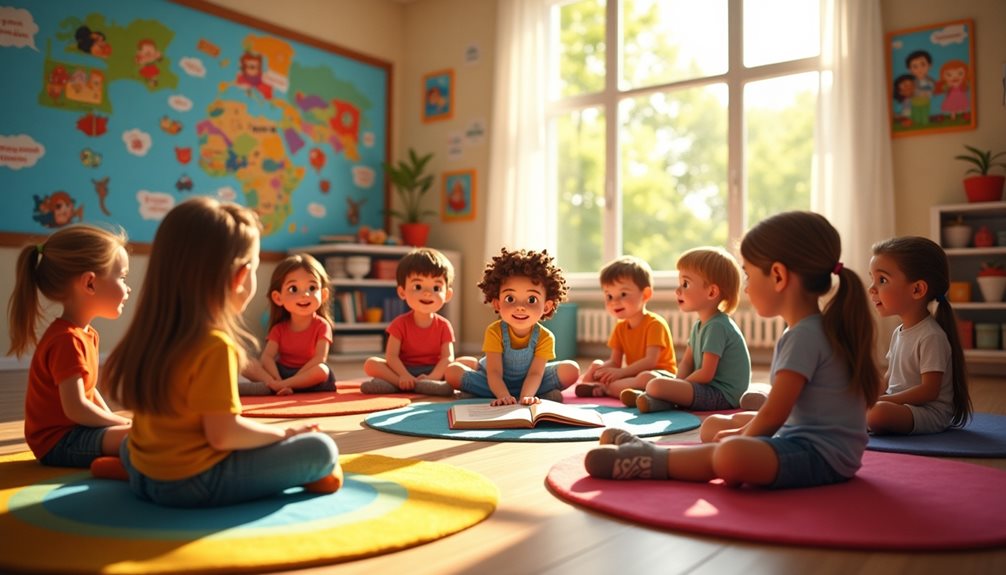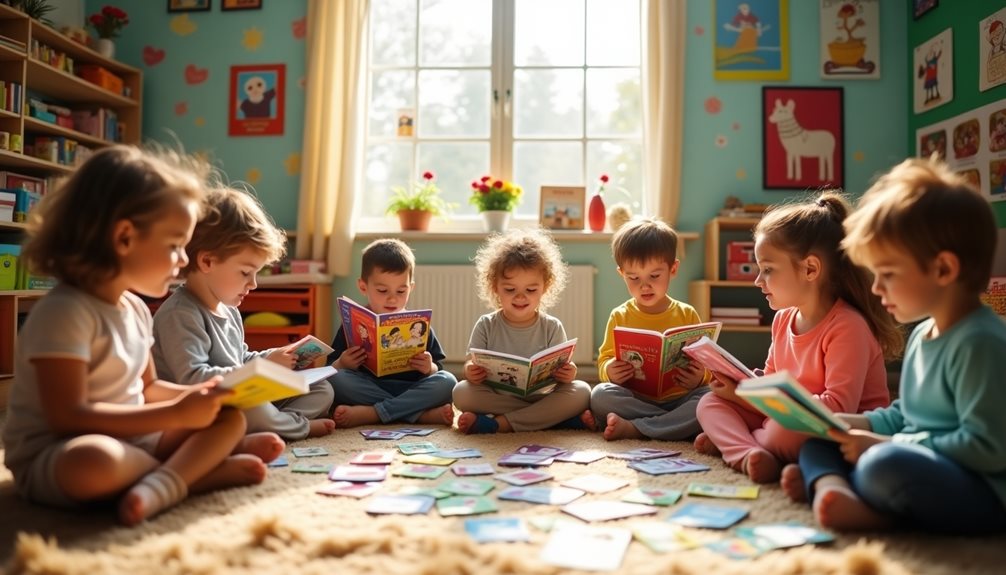Table of Contents
ToggleThe Benefits of Using Stories for Language Learning

As children explore the enchanting domain of stories, they access a treasure trove of language learning benefits that extend far beyond mere vocabulary acquisition.
Through engaging narratives, they enhance their story comprehension, allowing them to connect words with contexts and emotions. This immersive experience cultivates an understanding of syntax and grammar in a natural, enjoyable manner.
As they journey through colorful tales, children encounter diverse characters and settings, enriching their linguistic repertoire and cultural awareness.
In addition, the repetition and rhythm found in stories promote language retention, ensuring that new words and phrases become firmly rooted in memory.
Stories offer a unique and engaging way to develop language skills, making them a valuable resource in any language learning journey. Far from being just entertainment, stories provide a rich foundation for building vocabulary, understanding grammar, and exploring new cultures. By immersing learners in meaningful narratives, stories create a natural environment for language acquisition that is both enjoyable and effective. The following sections highlight some of the key benefits of using stories for language learning.
Comprehension and Context
Listening to or reading stories helps learners understand how language works in real-life situations. Narratives present vocabulary in context, making it easier to grasp meanings and how words are used. For example, children are more likely to remember the meaning of “whisper” if they encounter it in a story where a character whispers a secret.
Grammar and Structure
Stories demonstrate sentence structure and grammar rules without explicit instruction. Repeated exposure to correct language patterns helps learners internalize rules about word order, tense, and agreement. This process is similar to how native speakers acquire their first language.
Cultural Awareness
Stories often reflect cultural values, traditions, and social norms. By reading or listening to stories from different cultures, children expand their cultural knowledge and develop empathy for others. For instance, folk tales from around the world can introduce learners to unique customs or holiday traditions.
Memory and Retention
The repetitive language and rhythmic patterns found in many children’s stories (like fairy tales or rhymes) reinforce new vocabulary and phrases. Repetition is a key factor in moving information from short-term to long-term memory. Songs, chants, and predictable storylines all contribute to stronger recall.
Emotional Engagement
Stories captivate attention and evoke emotions, making the learning process enjoyable and memorable. Emotional connections to characters or plotlines increase motivation and curiosity, which are important for sustained language practice.
Improved Speaking and Listening Skills
Hearing stories read aloud exposes learners to pronunciation, intonation, and natural speech patterns. Retelling stories or acting out scenes encourages speaking practice and builds confidence in using the new language.
Long-Term Benefits
Regular exposure to stories can lead to greater reading fluency and a wider vocabulary base over time. Studies show that children who engage with stories from an early age tend to develop stronger literacy skills and perform better academically.
In summary, stories offer a multifaceted approach to language learning—blending vocabulary, grammar, cultural insights, and emotional connection in a way that is both effective and enjoyable.
Popular Russian Children’s Stories to Explore
Exploring Russian children’s literature unveils a rich tapestry of stories that have shaped generations. These tales, deeply woven into Russian culture, introduce readers to a colorful array of characters, settings, and life lessons. They are not just entertaining narratives but also gateways to understanding Russian language, traditions, and values.
Kolobok (Колобок)
This classic tale centers on Kolobok, a cheerful little bread roll who escapes from his elderly creators’ kitchen window. As Kolobok rolls through the forest, he encounters various animals—заяц (hare), волк (wolf), медведь (bear), and finally the cunning лиса (fox). Each animal tries to catch him, but Kolobok outsmarts them with a playful song—“Я от бабушки ушёл, я от дедушки ушёл…” (“I escaped from Grandma, I escaped from Grandpa…”). The story is beloved for its repetition and catchy rhymes, making it a favorite for teaching children simple sentence structures and animal names.
The Frog Princess (Царевна-Лягушка)
In this magical tale, a young prince named Ivan must find his bride in an unexpected way: by shooting an arrow and marrying whoever finds it. The arrow lands near a лягушка (frog), who turns out to be an enchanted princess. The story’s themes of transformation, loyalty, and the importance of seeing beyond appearances resonate deeply. Key phrases include волшебство (magic), принцесса (princess), and любовь (love). The Frog Princess teaches children about kindness and the rewards of looking for inner beauty.
The Wolf and the Seven Young Kids (Волк и семеро козлят)
This cautionary fable tells of a mother goat (мама-коза) who leaves her seven kids (семеро козлят) at home, warning them not to open the door to strangers. The wolf (волк) tries various tricks to deceive the kids and eventually succeeds by disguising his voice. The story emphasizes the importance of listening to parents (слушаться родителей) and being wary of strangers (остерегаться незнакомцев). Its repetitive structure helps reinforce vocabulary related to family and safety.
![]()
Three Bears (Три медведя)
This folk story, which inspired versions like Goldilocks and the Three Bears, features a curious girl who stumbles upon the house of three bears (медведи): Papa Bear (папа медведь), Mama Bear (мама медведица), and Baby Bear (медвежонок). She samples their porridge (каша), tries their chairs (стул), and naps in their beds (кровать), each time finding one that’s “just right”—“в самый раз.” The tale introduces concepts of size (маленький — small, большой — big) and politeness, alongside engaging repetition.
These stories are more than bedtime entertainment. Their rhythmic prose and memorable refrains help children absorb Russian words and phrases naturally. Through characters like Колобок or Царевна-лягушка, young readers not only gain language skills but also a deeper appreciation for Russian folklore. Key phrases from these stories—such as лес (forest), домик (little house), петь песню (to sing a song), and сказка (fairy tale)—become part of everyday vocabulary, enriching both language learning and cultural understanding.
Creative Activities to Enhance Vocabulary
Creative activities make learning new vocabulary both effective and enjoyable for young learners. When children are actively involved and having fun, they are more likely to remember and use new words in real-life situations.
Vocabulary Games
Games like word scavenger hunts and bingo are excellent tools for vocabulary building. In a word scavenger hunt, children receive a list of new words and search for objects or pictures around the classroom or home that match those words. This activity encourages movement, critical thinking, and reinforces connections between words and their meanings. Bingo can be adapted by placing words or definitions on the game cards. As the teacher calls out a word or definition, children mark the correct answer on their cards. These games foster a spirit of friendly competition and make repetition less monotonous.
Storytelling Prompts
Storytelling activities help children use new vocabulary in creative contexts. Prompts like “Describe a day in a city made entirely of candy” encourage students to use descriptive language and stretch their imaginations. Research shows that when learners use new words to create original stories, they remember those words better because they have made personal connections with them. Storytelling also builds confidence in speaking and helps develop better sentence structure and grammar skills.
Role-Play Scenarios
Role-play puts vocabulary into action. Children might pretend to be shopkeepers, doctors, astronauts, or characters from their favorite books. For example, in a pretend restaurant, students must use words related to food, ordering, and polite conversation. This type of play allows children to practice new vocabulary in a safe, supportive environment. Studies have shown that using language in context helps learners retain it longer and understand how it works in real communication.
Art and Music Integration
Drawing pictures of new words or creating songs using vocabulary terms can also deepen understanding. When children illustrate a word, they are thinking about its meaning and how it can be represented visually. Singing vocabulary songs helps with pronunciation and memory through rhythm and repetition.
Why These Activities Work
Children learn best when they are engaged emotionally and physically. Creative activities activate different parts of the brain, making learning more holistic. They also provide repeated exposure to new words in various contexts, which is essential for long-term retention.
By turning vocabulary lessons into interactive experiences, children not only learn faster but also enjoy the process, increasing their motivation to keep expanding their language skills.
Common Russian Words and Phrases
| Russian Word/Phrase | English Phonetic | English Translation |
|---|---|---|
| мама | ma-ma | mom |
| папа | pa-pa | dad |
| привет | pree-vyet | hello |
| пока | pa-ka | bye |
| спасибо | spa-see-ba | thank you |
| пожалуйста | pa-zhal-sta | please / you’re welcome |
| да | da | yes |
| нет | nyet | no |
| кот | koht | cat |
| собака | sa-ba-ka | dog |
| дом | dom | house |
| школа | shko-la | school |
| вода | va-da | water |
| хлеб | khlyeb | bread |
| яблоко | ya-bluh-ka | apple |
| мама дома | ma-ma doh-ma | mom is at home |
| это | eh-ta | this/it is |
| я | ya | I |
| ты | ti | you (informal) |
| друг | droog | friend (male) |
| подруга | pa-droo-ga | friend (female) |
Incorporating Visual Aids in Storytelling
Incorporating visual aids into storytelling is an effective way to capture children’s attention and make stories more memorable. When children see images alongside a story, their brains connect the words they hear or read with visual representations, which helps them understand and remember the narrative better. For language learning, especially Russian, visual aids can be especially powerful—they help children associate new Russian words with familiar images, making vocabulary stick.
Picture books are a classic example of combining text and visuals. The illustrations do more than decorate the page; they clarify meaning, express emotions, and sometimes even tell parts of the story that aren’t in the text. For example, a picture of a bear (медведь — “med-VYED'”) fishing in a river instantly shows what the Russian word means, even if the child has never heard it before.
Bright and engaging illustrations are key. When characters are drawn with expressive faces or unique outfits, children notice details that make the story come alive. This is especially useful for words describing appearance or emotions. For example:
- радость (RA-dost’) — joy
- грусть (groost’) — sadness
- смелый (SME-lyy) — brave
Maps are another valuable visual aid in storytelling. They help children visualize the journey of characters through different lands and settings. A map labeled with Russian location words can reinforce vocabulary like:
- лес (les) — forest
- город (GO-rud) — city
- река (ree-KA) — river
- замок (ZA-muk) — castle
Interactive elements, such as flaps to lift or pop-up illustrations, add a tactile component to the story. As children physically interact with the book, they become more invested in the narrative. For instance, opening a flap to reveal what’s behind a door can reinforce the word дверь (dver’) for “door,” while popping up a tree can help remember дерево (DYE-re-va) for “tree.”
Visual summaries at the end of a story are helpful for reinforcing key concepts and vocabulary. These might include labeled pictures of main characters, items found in the story, or important events. Children can review these at the end to recall words and concepts in Russian, such as:
- друг (droog) — friend
- волшебство (vol-sheeb-STVO) — magic
- приключение (pree-klyu-CHEN-ee-ye) — adventure
Overall, using visual aids makes storytelling more engaging and interactive. It sparks curiosity and makes learning Russian words and phrases an enjoyable process for children. Visual storytelling is not just about seeing—it’s about connecting language, imagination, and understanding in a way that feels natural and fun.
These aids not only enrich the narrative but also stimulate curiosity, making the learning of new words and ideas an exciting adventure.
Tips for Parents on Reading Aloud
Reading aloud to children is much more than just a bedtime routine—it is a powerful tool for building language, literacy, and emotional bonds. When parents set aside time to read with their children, they are not only sharing stories but also modeling a love for books and learning. This early exposure to literature helps children associate reading with comfort and enjoyment, making it more likely that they will develop a lifelong passion for books.
One of the most effective ways to make reading aloud engaging is through interactive storytelling. By using different voices, tones, and facial expressions, parents can bring characters to life and make stories memorable. For example, giving the Big Bad Wolf a deep, growly voice or making Little Red Riding Hood’s voice light and cheerful adds excitement that draws children in. These dramatic touches help children follow the plot and remember details, while also demonstrating how expressive reading can make stories come alive.
Involving children in the reading process deepens their connection to the story. Parents can pause to ask questions such as “What do you think will happen next?” or “Why do you think the character did that?” These simple questions encourage children to think critically and use their imaginations. Predicting outcomes or discussing characters’ motives helps children develop reasoning skills and makes them active participants rather than passive listeners. This kind of engagement also builds vocabulary, as children are exposed to new words in context and have opportunities to ask what they mean.
Choosing stories rich in vocabulary and cultural references broadens children’s understanding of the world. Books introduce them to people, places, and ideas they might not encounter in everyday life. For example, folk tales from different cultures or stories set in faraway lands can spark curiosity about traditions and customs. When parents explain unfamiliar words or concepts, they help their children build a strong vocabulary and become more confident readers.
The environment in which reading takes place matters as well. Creating a cozy and distraction-free space helps children focus on the story. This could mean turning off the television, putting away electronic devices, and snuggling up on a comfortable chair or bed. A quiet, comfortable setting signals that reading time is special and worth looking forward to. Over time, these moments become cherished memories that strengthen the parent-child bond.
Most importantly, reading aloud offers parents and children a chance to connect emotionally. As they laugh at funny parts, feel suspense during exciting scenes, or comfort each other during sad moments, they share a range of feelings that bring them closer together. These shared experiences foster empathy and teach valuable social skills.
By making reading aloud a regular part of family life, parents give their children a strong foundation in language and literacy. The benefits extend far beyond improving reading skills—children learn to express themselves clearly, listen attentively, and appreciate stories from many perspectives. All of these skills are essential for success both in school and in life.
Online Resources for Russian Children’s Literature

An abundance of online resources awaits those seeking to explore the rich fabric of Russian children’s literature.
These digital libraries and interactive platforms offer a treasure trove of enchanting tales and vivid illustrations that captivate young minds. Readers can plunge into:
- Classic fairy tales filled with whimsical characters
- Modern stories that reflect contemporary life and values
- Audiobooks that immerse listeners in narrative adventures
- Interactive games that enhance vocabulary and comprehension
These resources not only empower children to discover the magic of storytelling but also foster a love for the Russian language.
As they journey through these online domains, they experience the joy of learning, creativity, and cultural heritage, making the process of acquiring language skills both engaging and liberating.
Frequently Asked Questions
How Can I Find Russian Children’s Stories Online?
To find Russian children’s stories online, one can explore various online resources and dedicated story websites. These platforms offer a treasure trove of imaginative tales, fostering a love for language and storytelling in a delightful manner.
What Age Group Is Best for Starting Russian Stories?
Determining the ideal age for introducing Russian stories hinges on cognitive development milestones. Typically, ages three to six foster imaginative engagement, enhancing language skills while nurturing curiosity, making this period particularly advantageous for early literary exploration.
Can I Use Translations of Stories for Learning?
Using translations of stories enhances comprehension and promotes engagement. The translation benefits allow learners to connect with narratives while expanding vocabulary, creating an enriching, imaginative experience that fosters a deeper understanding of language and cultural nuances.
How Do I Choose the Right Story for My Child?
When selecting a story, one should consider engaging story themes and enriching character development. These elements can captivate a child’s imagination, fostering a love for reading while enhancing their emotional and intellectual growth through relatable experiences.



